Underfloor heating guide - everything you need to know
The ultimate guide for how to choose, have installed and maintain UFH in your home

If the idea of padding around your home barefoot appeals, it’s possible that underfloor heating (UFH) is a perfect solution for your home. Each system comprises a network of heated pipes or cables laid directly beneath your flooring, transforming the entire surface into a radiant heat emitter.
As well helping to keep you warm in winter with its even spread of warmth across the whole room, underfloor heating frees up your walls from radiators. This gives you more options when it comes to rearranging furniture layouts.
Underfloor heating: a complete guide
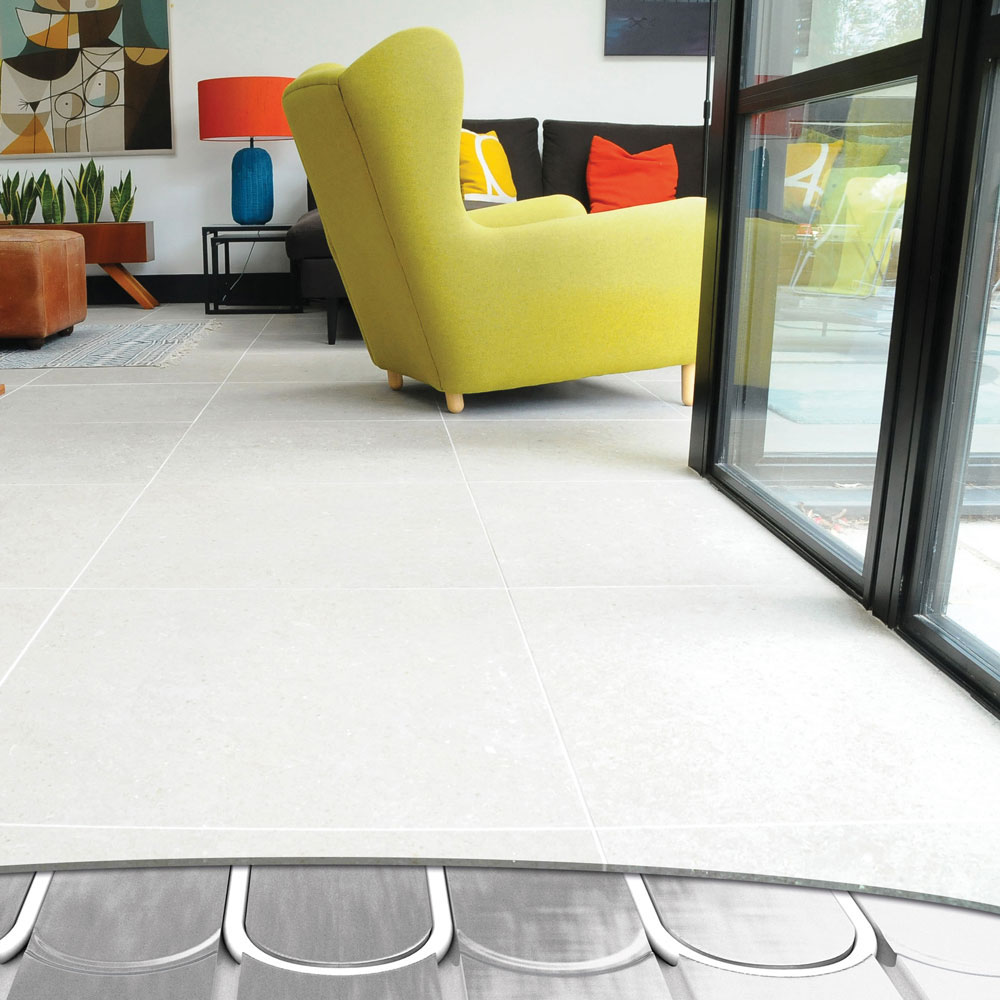
There’s a whole raft of benefits that come with switching to a correctly specified underfloor heating system. 'Efficiency is one major advantage which, in turn, leads to cost savings on your utility bills,' says Tom Edmunds, general manager at Wunda Group. 'Input temperatures can be as low as 40°C, using a lot less energy/fuel than a radiator, which typically requires temperatures of 70-90°C.’
And the benefits don’t stop there – one of the lesser-known advantages of UFH is that it minimises the movement of dust throughout your home. 'Radiators circulate air around a room, which moves dust that we breathe in,' says Tom. 'That’s why UFH is recommended for homes with asthma and allergy sufferers.'
Here, we talk you through the basics, from tracking down the products and suppliers, to maintenance and running costs.
What types of underfloor heating are available and how do they work?
There are two main options:
1. Warm water underfloor heating
A hydronic setup is connected to your central heating system, powered by a boiler or some form of renewable tech (eg a heat pump). Warm water systems, such as those available at The Underfloor Heating Store, feature an array of pipes, laid just below the surface of your floor. When the system is switched on, water (around 30°C-35°C) is circulated through the pipes to warm the floor above, thereby heating the whole room.
Get the Ideal Home Newsletter
Sign up to our newsletter for style and decor inspiration, house makeovers, project advice and more.
Most systems are divided into distinct zones, each of which is connected to a central manifold that monitors the level of warmth in each area. Individual thermostats can then be used to control the temperature in each of the zones.
The piping for a warm-water system is often embedded into a layer of sand and cement screed, usually resulting in build-up of around 75mm. This system is well-suited to new builds. If you’re renovating and want to minimise floor height build-up as much as possible, slim, low-profile systems are available. Such solutions often comprise castellated panels that hold the warm water tubes in place. These would be laid above the existing floor, with a self-levelling compound poured on top.
'Water-based UFH systems are typically recommended for new build projects where the system will be the primary source of heat throughout the house,' says Luciana Kola, marketing manager at Uponor UK. 'They are also preferable for heating up larger rooms. Although they are more expensive to install [than electric], they are cheaper to run in the long-term, making them more cost-efficient when it comes to heating large areas.'
2. Electric/dry underfloor heating
This type of system runs off your domestic electricity supply. There are two main types available: systems formed from loose wires laid beneath the floor surface, or those that have been embedded into a mesh mat. Both solutions can be laid onto the existing substrate to warm the floor surface above.
On the plus side, an electric system will warm up quicker than a water-based arrangement. Making it ideal for areas like adding underfloor heating in bathrooms, where a speedy response time is desirable. Plus, the wiring is thin and easy to fit, resulting in little height build up to your floors.
'Electric systems are also preferable if you’re fitting the heating in just one or two small rooms, as they are quick, easy and cheap to install,' says Luciana from Uponor. The ease of installation also makes dry UFH a smart choice if you want to add one room onto an existing UFH arrangement, or if you want to fit it on a DIY basis. For example, sticky mat systems that come with system controls and a detailed installation manual are well within the capabilities of a competent DIYer.
On the downside, electric systems tend to lose heat quicker than hydronic systems once turned off. The running costs will likely be higher, as electricity costs per more kWh than the natural gas. That’s why electric systems tend to work well as standalone solutions used in one or two small rooms.
How is underfloor heating installed?
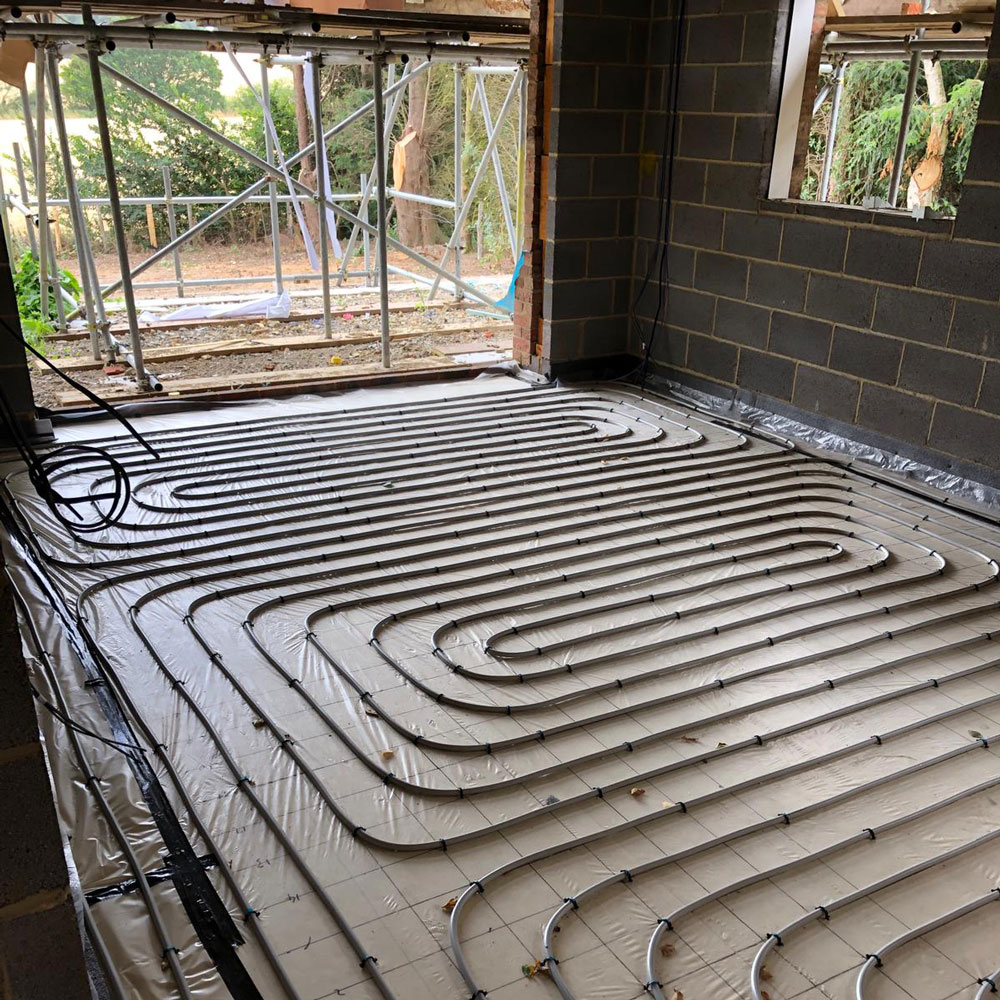
- As a first step, speak to a professional heating engineer who can conduct heat loss calculations in the rooms where you’re planning to install UFH. With this data to hand, he or she is able to design a system using products that meet the unique requirements of the space.
- The floor/subfloor needs to be cleaned and prepped. File down any bumps and use grout to fill in cracks, establishing a smooth, even surface.
- Insulation is fitted to sit beneath the heating system itself, so warmth is not lost downwards. Make sure this layer is level and free from gaps.
- The manifold is connected to your existing water supply via the pump and mixing valve. Make sure it is positioned in a place where it is easily accessible for future maintenance.
- The pipework for your underfloor heating is laid out at neat, even intervals in a snake-like pattern across the surface of the floor. The pipework is then connected to the manifold so it can be flushed, filled and pressurised to clear any debris from the pipes.
- Screed is laid over the top to help spread heat across the whole surface of your floor. This layer will either be made of a sand and cement mix or it’ll be a self-levelling liquid compound. Once this layer has been laid, it needs time to dry out thoroughly. Don’t be tempted to turn on the heating system to speed up the drying process, as this may lead to cracking.
- Once the screed has cured properly, your choice of floor covering can be laid down.
Which floor coverings work best with underfloor heating?
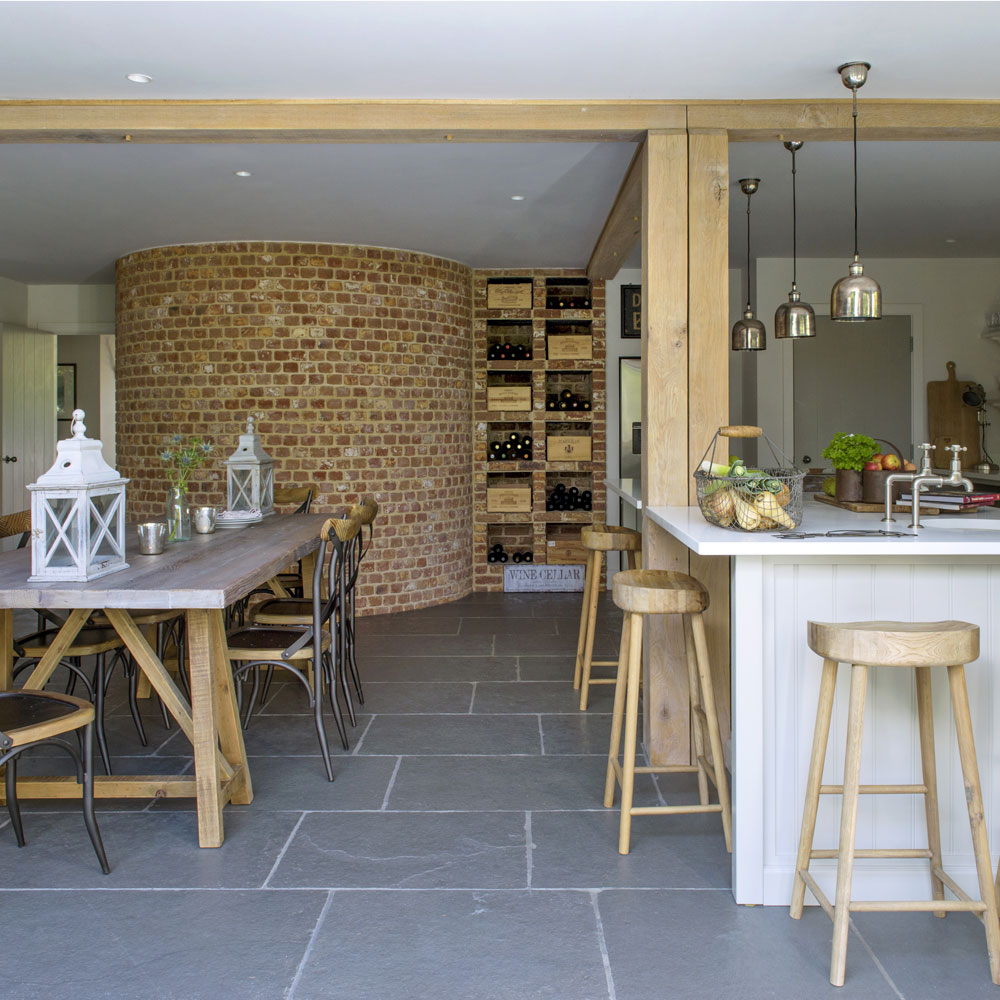
Suitable for new build homes, renovation scenarios and extensions, you can either add in new or retrofit underfloor heating with an array of floor coverings – though the finish you choose will have to be specified carefully to ensure your system runs efficiently.
It’s worth doing your homework at the design stage of your project to ensure you choose the solution that best fits your home. For example, the best setup for an ensuite refurb will be very different to the one required for a large, open-plan kitchen-diner.
- Stone flooring –Durable, long-lasting and full of character, stone flooring provides a fantastic match for UFH. Marble probably provides the best thermal conductivity of the natural stones, which means it will transmit heat up into your room quicker. Limestone, terracotta and slate are all striking and effective options, too. Another advantage is that stone floors will retain the heat for some time after your system has been switched off. A decoupling membrane may be required before the tiles are fitted, allowing for any movement in the subfloor.
- Ceramic & porcelain tiles: Underfloor heating takes the chill off what would otherwise be a cool surface underfoot. Both material options come with excellent thermal conductivity, which means they’ll transmit the warmth from your heating system into the room effectively. Porcelain is hardier than ceramic, which gives it a slight edge in that you’re less likely to have to replace any porcelain tiles that sit above your UFH in the future. Another bonus is that both types of tile will retain heat well over time.
- Wood: Few man made materials can match the characterful appeal of natural timber floors. However, if you plan on installing underfloor heating with wooden floors, engineered boards are typically a better fit than solid planks. The cross-dimensional structure of the boards is finished with a veneer of real wood, so you get the aesthetic appeal of real timber with less risk of expansion and contraction as the wood heats and cools. Solid hardwood and softwood products can be used in some scenarios, but always check your manufacturer’s guidelines and pay close attention to the thickness of the boards. 'Be sure to install a floor probe to protect the integrity of the wood from fluctuating temperatures,' says Tom from Wunda. 'Do check with your flooring supplier, as some products like Beech and Maple may not be compatible.'
- Laminate & vinyl: If you’re looking to introduce a splash of colour into your home, vinyl and laminate are both practical, low-maintenance options. Vinyl can be paired with UFH, though it should only be fitted over water-based systems rather than electric mat-based arrangements – the same goes for laminate, too. Luxury vinyl tiles are also compatible with UFH, though always check your flooring supplier’s guidance regarding how high the temperature should be set, as there’s sometimes an upper limit you’ll have to adhere to.
- Carpet: While it is possible to have underfloor heating with a carpet, the soft surface of the material isn’t the best natural conductor of heat. For efficient heat transfer, the combined tog value of the underlay and the carpet itself should be no greater than 2.5. Felt and polyurethane underlays should be avoided, as they may affect the transfer of heat.
What rooms are best for underfloor heating?
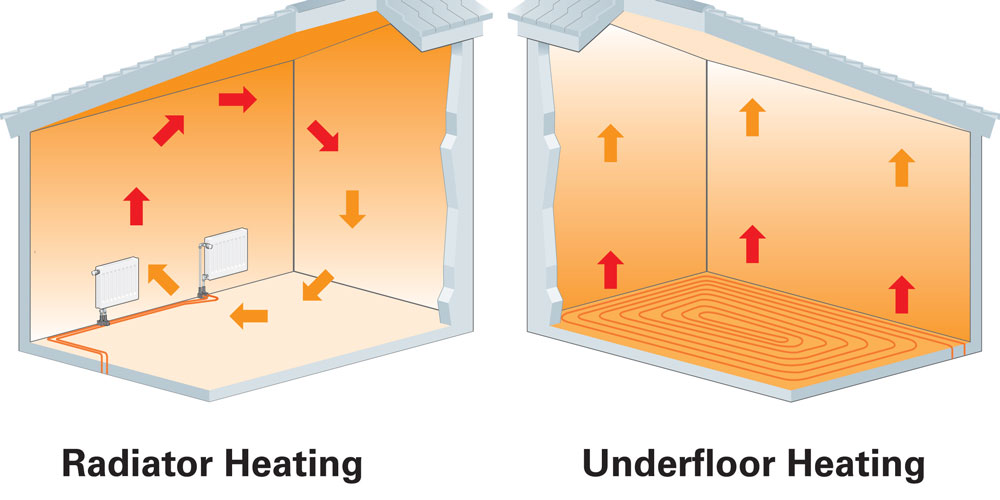
To some extent, this depends on personal preference – and how much cash is in your project fund. If you have a strict budget for your whole house refurb, for instance, fitting underfloor heating downstairs in the areas where you spend most time could be an economical route. Then, radiators can be installed upstairs in bedrooms to provide short bursts of heat when needed.
The bathroom is a wonderful area to invest in underfloor heating, as it’s certainly a place where you’ll enjoy a cosy feel underfoot. 'There’s nothing appealing about stepping out of the shower onto a cold, hard surface,' says Adam Chard, content manager at Victoria Plum. 'Underfloor heating gives a constant temperature, distributing the heat evenly across the space.' You can always add in a small towel rail, too, to keep towels toasty.
Underfloor heating works beautifully in open-plan living areas, too. 'I tend to suggest it for kitchen-living-dining zones, as the floor area that can be used for the heating is quite large and fairly unobstructed,' says Michael Schienke, director at Vorbild Architecture. 'It helps in situations where full width glass doors are proposed, too.'
How is underfloor heating controlled?
Like a regular central heating setup, UFH is controlled via a thermostat that allows you to manage the temperature settings and timings for each room. Learning how to manage your heating effectively will save both energy and money, as you won’t be wasting your pennies on overheating the house. Typically, living areas are set to a temperature of around 21°C while bedrooms are slightly cooler, at around 18°C.
Many homeowners are turning to smart heating solutions. 'Smart setups are very popular now, and while you won’t need to adjust the UFH once it’s been set up, the ability to turn it on while you’re on holiday is a must,' says Matt Densham from Robbens. 'This is because there can be a delay on the initial heat up times.'
Who supplies the best underfloor heating?
There’s a selection of reputable suppliers to choose from, so it’s a case of doing your research to find a system from a well-established manufacturer that’s highly rated by other homeowners. 'Be aware of cheap UFH components – especially pipework,' says Matt from Robbens. 'A good quality UFH pipe will be designed to last in excess of 50 years and will come with insurance backed guarantees.'
The quality of the warranty offered by your supplier is another aspect to check out, as it’ll give you peace of mind once the system has been installed. Warmup’s Safety Net Installation Guarantee protects against any accidental damage caused to a Warmup system during the installation process. 'For instance, if your installer accidentally cuts a heating wire in one of our electric heating mats, Warmup will provide a replacement heater, free of charge. Always make sure to complete your guarantees within 30 days of purchase,' says Sarah Wazir, a marketing executive at Warmup.
Choosing the right installer is just as important as selecting your supplier. You could fork out plenty of cash on the best components money can buy, but if they’re not fitted properly then your heating system will never deliver the results you expected.
Many manufacturers have their own national network of installers trained and registered to fit their products, so this can be a useful starting point. These professionals will have had plenty of experience fitting the exact products you’re buying.
How do you maintain underfloor heating?
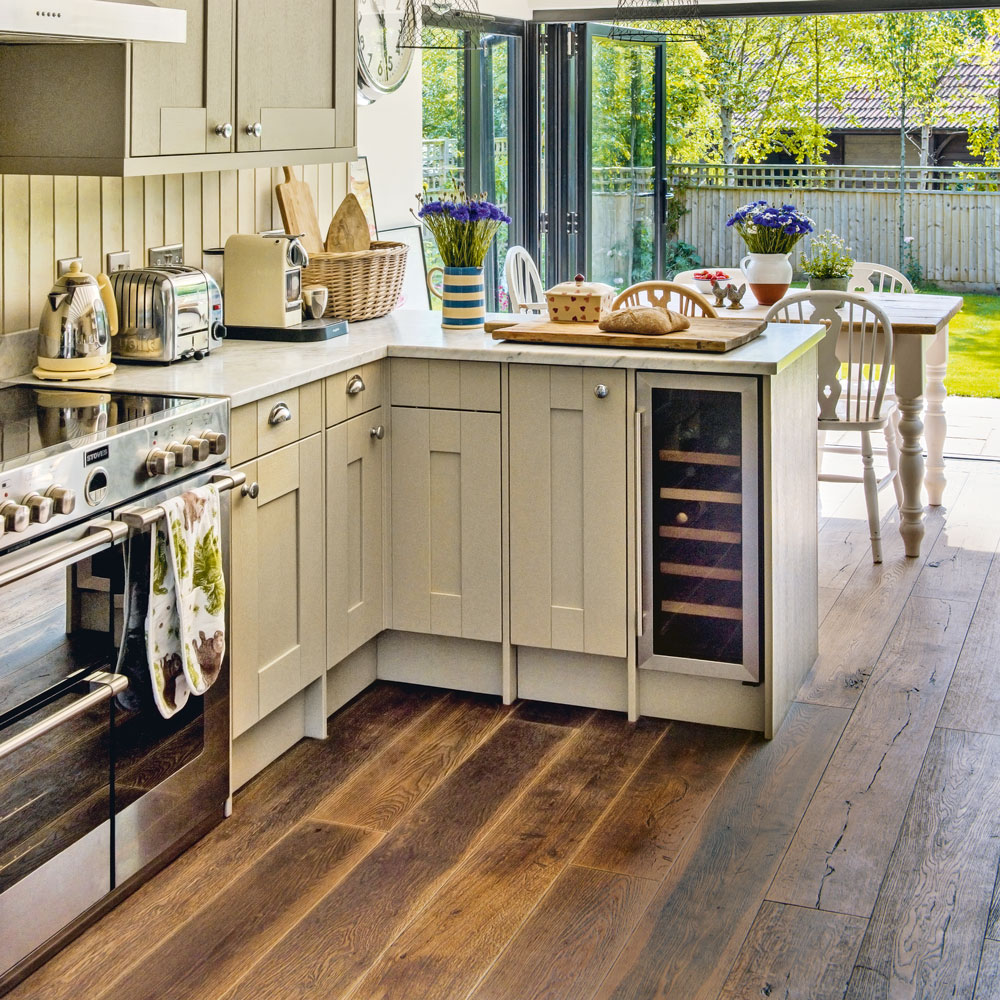
If you're debating underfloor heating vs radiators, know that UFH requires less upkeep than a conventional radiator system. 'For example, it doesn’t need to be checked for air in the system or bled,' says Luciana from Uponor. To ensure your heating requires as little maintenance as possible, a high-quality installation is essential.
'Most problems that users experience with their UFH systems are as the result of an inadequate installation. We always recommend you choose an installer who has worked with UFH before,' adds Luciana.
Though UFH is largely maintenance-free, it’s still worth having a heating engineer come out once a year for a service. A check-up will be able to identify any wear and tear on the system before faults occur – holding off until your heating fails to work properly will likely cost more to fix and leave you feeling chilly while you wait for the issue to be resolved.
Common issues might include air trapped in the system, unbalanced flow rates or blockages from debris. Preventative services and upkeep will keep your system running smoothly for longer.
What does it cost to install and maintain underfloor heating?
Exact underfloor heating costs will vary, depending on the solution you’ve chosen and the type of property you’re putting it into. If you’re fitting a hydronic system, it’ll be cheaper to fit in a new build or extension rather than a retrofit scenario.
According to Nu-Heat, in a typical new build with a 100m2 floor area, a bespoke screeded warm water system would cost between £2,800 and £3,000 for a 30m2 area (around £30 per m2, excluding the screed itself). In a renovation project, taking an average Victorian terrace with a downstairs floor area of 60m2 as an example, Nu-Heat’s bespoke LoPro10 system (a low-profile setup designed specifically for renovation projects), the cost would be more in the region of £4,000 (around £65 per m2).
Likewise, there are various types of electric UFH, all of which cost a different amount to install. DIY heat mats sit at the lowest end of the scale in terms of cost and could set you back as little as £20 per m2 if you’re happy to take on the installation yourself. Many systems set around the £50 per m2 mark, though more advanced systems could cost up to £85 per m2. Always remember to check whether items such as insulation and thermostats are included in the price.
Running costs will also vary, depending on the type of system you’ve installed (hydronic or electric), the size of the space you’re heating and the thermal efficiency of your home.
'It’s a hard one to call, because UFH uses low temperature water, so there are immediate savings to be gained,' says Tom from Wunda. 'However, because it uses low temperature water over a large area, it warms the property in a completely different way.'
According to Checkatrade, it’ll cost between £26.60 and £30 per month to run UFH on a 10m2 floor area for up to four hours per day.

Rebecca Foster started her journalism career in Bangkok in 2013, where she worked on the in-house editorial team at a luxury homes magazine. Since then, Rebecca has contributed to numerous property and interiors titles in the UK and Southeast Asia. She re-located to London in 2015 to work at one of the country’s leading self-build and home renovation magazines. In 2017, she left her job to split her time between freelance journalism and teaching yoga.
-
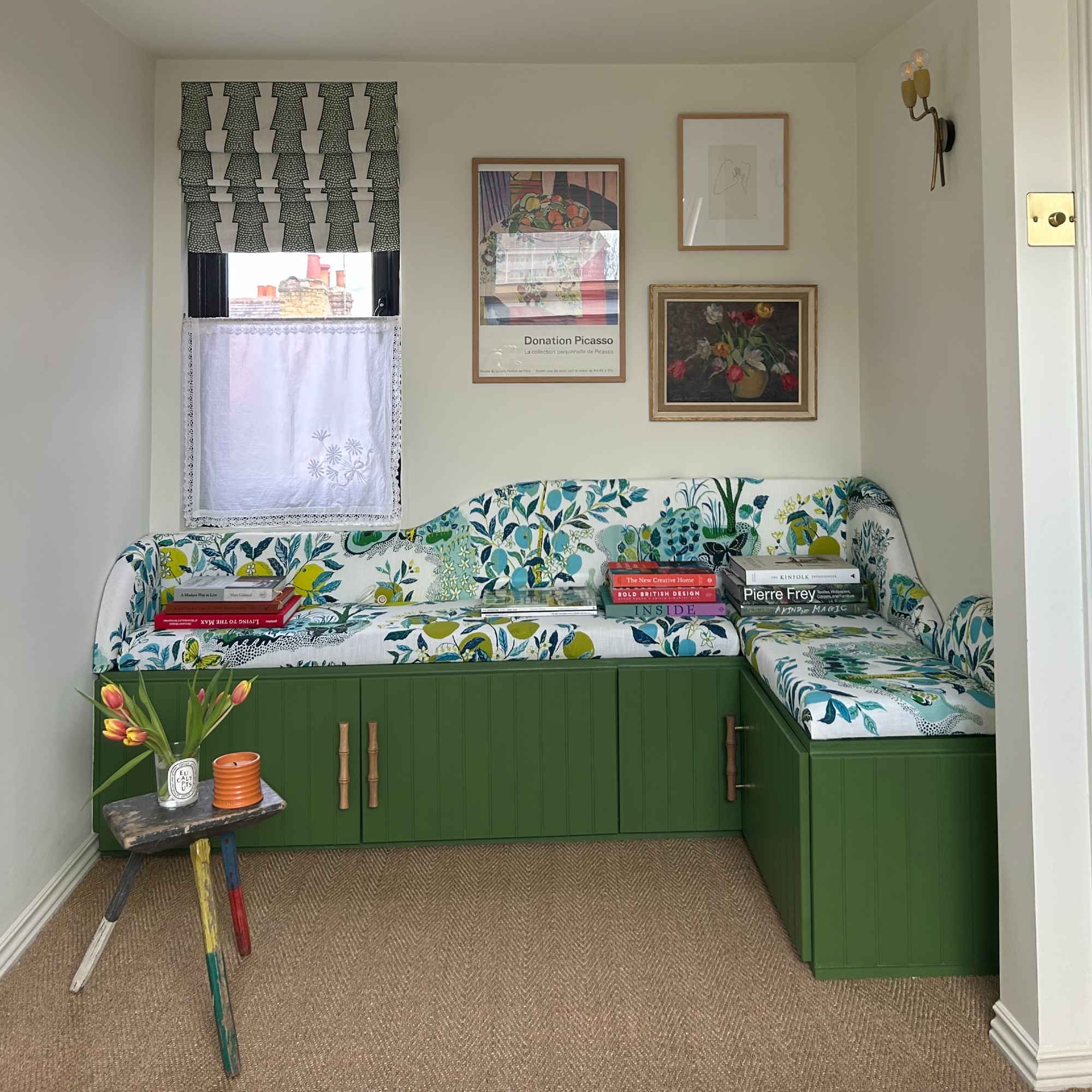 5 IKEA BESTA hacks that will transform your basic storage cabinets into stylish pieces with a high-end look
5 IKEA BESTA hacks that will transform your basic storage cabinets into stylish pieces with a high-end lookNot sure what to do with your BESTA storage cabinets? These hacks will give you plenty of inspiration to work with
By Sara Hesikova
-
 This secret gardening ingredient could be the key to stronger rose plants – and even more flowers
This secret gardening ingredient could be the key to stronger rose plants – and even more flowersIs mycorrhizal fungi worth it? We spoke to the experts to find out...
By Sophie King
-
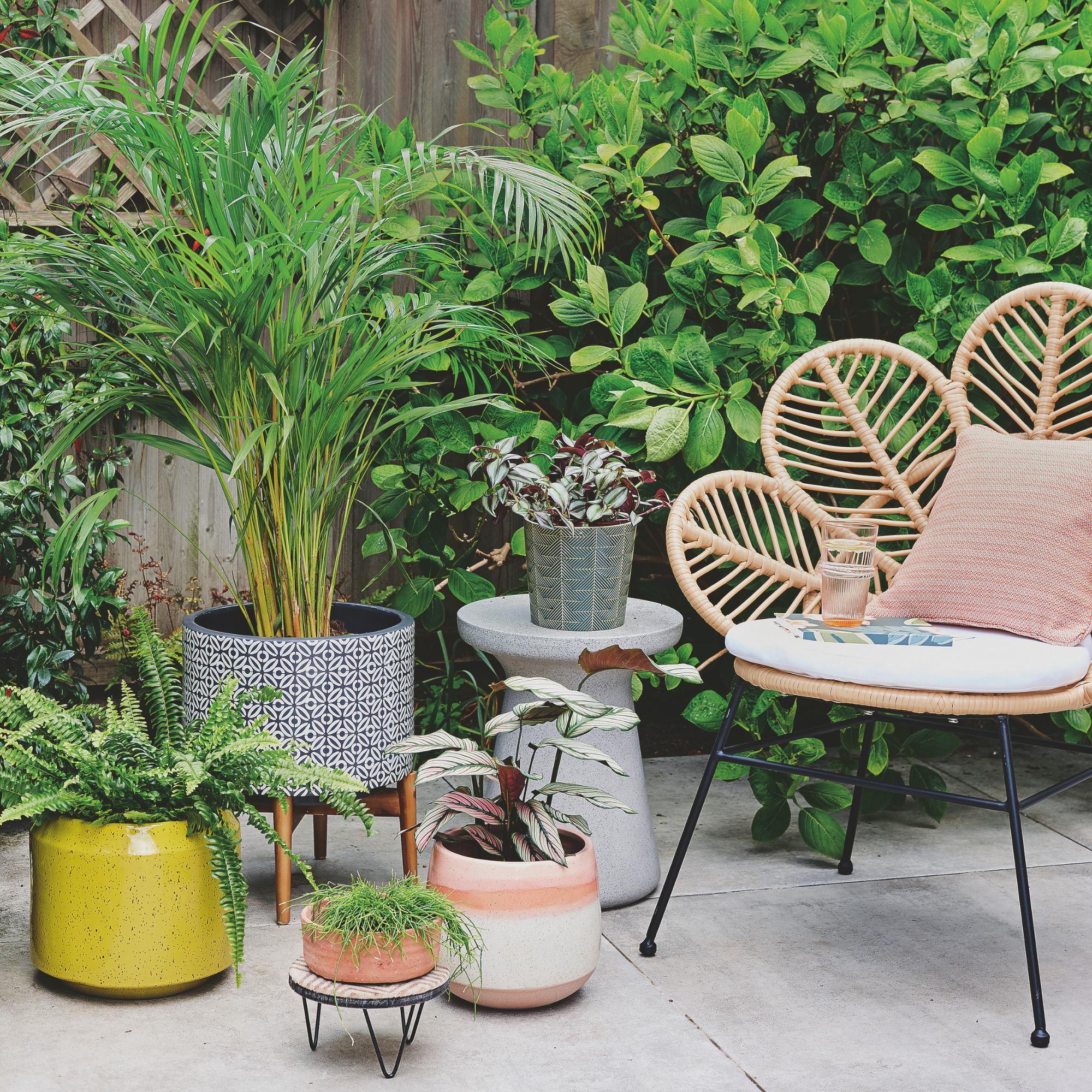 3 ways to use plants to Feng Shui your patio for calming outdoor space - and the blooms the experts swear by to achieve this
3 ways to use plants to Feng Shui your patio for calming outdoor space - and the blooms the experts swear by to achieve thisWant your patio to feel like a calming space? Then you need to know how to apply Feng Shui to your plants
By Kezia Reynolds